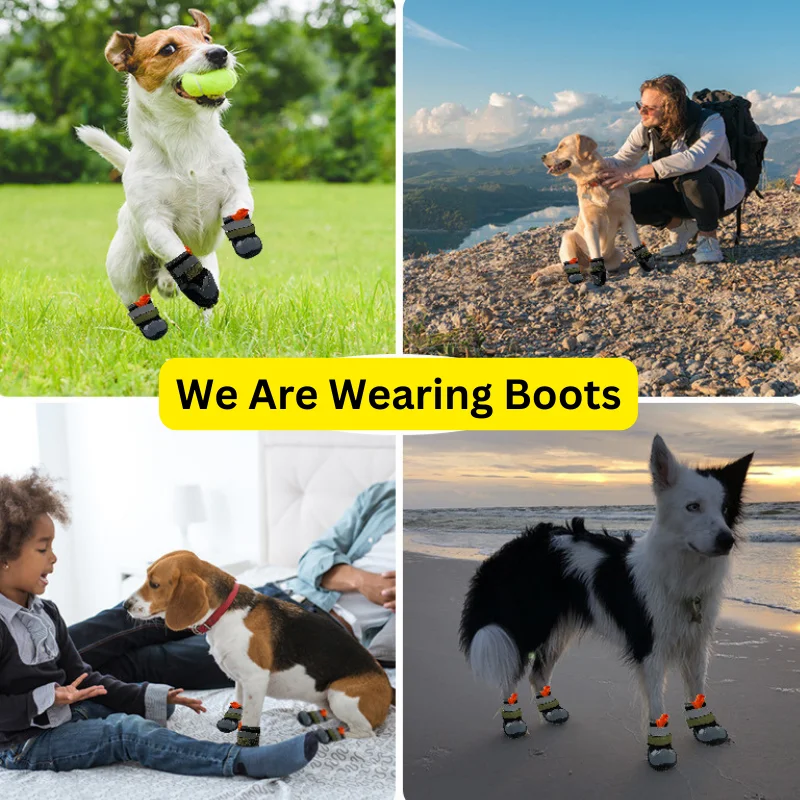Have you ever wondered why dogs need boots? While it may initially seem unusual, dog boots offer a range of benefits and are essential for protecting your furry friend’s paws in various situations. From extreme weather conditions to rugged terrains, boots provide a layer of insulation, support, and shield against potential injuries. Whether you’re taking your dog on a hike, walking on hot pavement or freezing snow, or simply want to keep their paws safe and comfortable, investing in the right boots is a wise decision.

1. Protection from Extreme Weather Conditions
Just like humans, dogs can experience discomfort and injury from extreme weather conditions. Dog boots act as a protective barrier against scorching pavement, freezing snow, and other harsh elements. In hot weather, boots provide insulation and prevent paw pad burns caused by hot pavement or sand. During winter, they shield your dog’s paws from ice, snow, and harmful chemicals used on sidewalks, such as de-icing agents. By wearing boots, you ensure your dog’s paws stay safe and comfortable when going outside, regardless of the temperature.
2. Preventing Injuries and Cuts
Outdoor adventures often include rugged terrains, sharp rocks, thorns, and broken glass, which can pose potential hazards for your dog’s sensitive paws. Boots offer a layer of insulation and protection, reducing the risk of cuts, scratches, and puncture wounds. The durable material of boots acts as a barrier, shielding your dog’s paws from sharp objects and preventing injuries. Additionally, boots provide stability and support, minimizing the chances of strains or sprains during rigorous activities. With boots, your dog can explore with confidence, knowing their paws are well-protected.
3. Safety During Outdoor Activities
Whether you’re hiking, trail running, or simply enjoying long walks in nature, dog boots are essential for ensuring your dog’s safety and preventing accidents. Boots with non-slip soles provide traction on slippery surfaces, such as wet rocks or muddy trails, preventing slips and falls. They also offer added visibility, especially if they have reflective strips or bright colors, making it easier to spot your dog in low-light conditions. By equipping your dog with boots, you enhance their safety and reduce the risk of injuries during outdoor adventures.
4. Post-Surgery or Injury Protection
If your dog has undergone paw surgery or has an existing injury, boots play a crucial role in the healing process. They provide a protective barrier, preventing the dog from licking or chewing the affected area, which could lead to infection or further damage. Boots also minimize the risk of dirt and debris entering the wound, allowing for a cleaner and faster recovery. Additionally, boots can help distribute pressure evenly on the paws, reducing discomfort and promoting proper healing. By using boots, you aid in your dog’s rehabilitation and ensure a smoother healing journey.
How to Choose the Right Dog Boots:
a) Measure Your Dog’s Paws: Accurate measurements are essential for selecting the right size of boots for your dog. Measure the length and width of your dog’s paws, following the manufacturer’s guidelines. Consider any specific instructions for measuring, as different brands may have slight variations. It’s important to measure each paw individually, as they may vary in size.
b) Assess the Boot’s Material: Look for boots made from durable, breathable, and water-resistant materials. Quality boots are typically constructed with materials like neoprene, rubber, or synthetic fabrics that provide protection while allowing airflow. Opt for boots with sturdy soles that provide traction, yet are flexible enough to allow natural movement. Additionally, ensure the boots are easy to clean and maintain, as they will inevitably become dirty during outdoor activities.
c) Consider Closure Systems: Boots typically feature various closure systems, such as Velcro straps, zippers, or elastic bands. Choose a closure mechanism that provides a secure fit while being easy to put on and take off. Velcro straps are popular because they offer adjustability and a snug fit, allowing you to customize the tightness to your dog’s individual paw shape.
d) Try Them On and Observe Fit: Once you’ve selected a pair of boots, carefully put them on your dog’s paws. Observe how they fit—boots should be snug but not too tight, allowing room for natural paw movement. Ensure the boots stay in place during walking or running. If the boots are too loose, they may slip off, while boots that are too tight can restrict blood circulation or cause discomfort. Pay attention to any signs of discomfort or irritation, such as excessive paw licking or limping, as these may indicate an improper fit.
e) Gradual Introduction and Training: Dogs may require time to adjust to wearing boots, especially if they have never worn them before. Start with short sessionsand gradually increase the duration. Begin by allowing your dog to wear the boots indoors for short periods, offering positive reinforcement and treats to create a positive association. Gradually transition to outdoor use, starting with familiar environments before venturing into more challenging terrains. Patience and consistency are key during the training process, as some dogs may initially resist wearing boots. With time and positive reinforcement, most dogs adapt and even come to appreciate the added protection and comfort provided by the boots.
Conclusion
Dog boots are not just a fashion statement; they are a practical and essential accessory for protecting your dog’s paws from various hazards and extreme weather conditions. By choosing the right pair, you provide your furry friend with optimal paw protection, ensuring their comfort, safety, and overall well-being. So, gear up your pup with boots and embark on exciting adventures together, worry-free!
